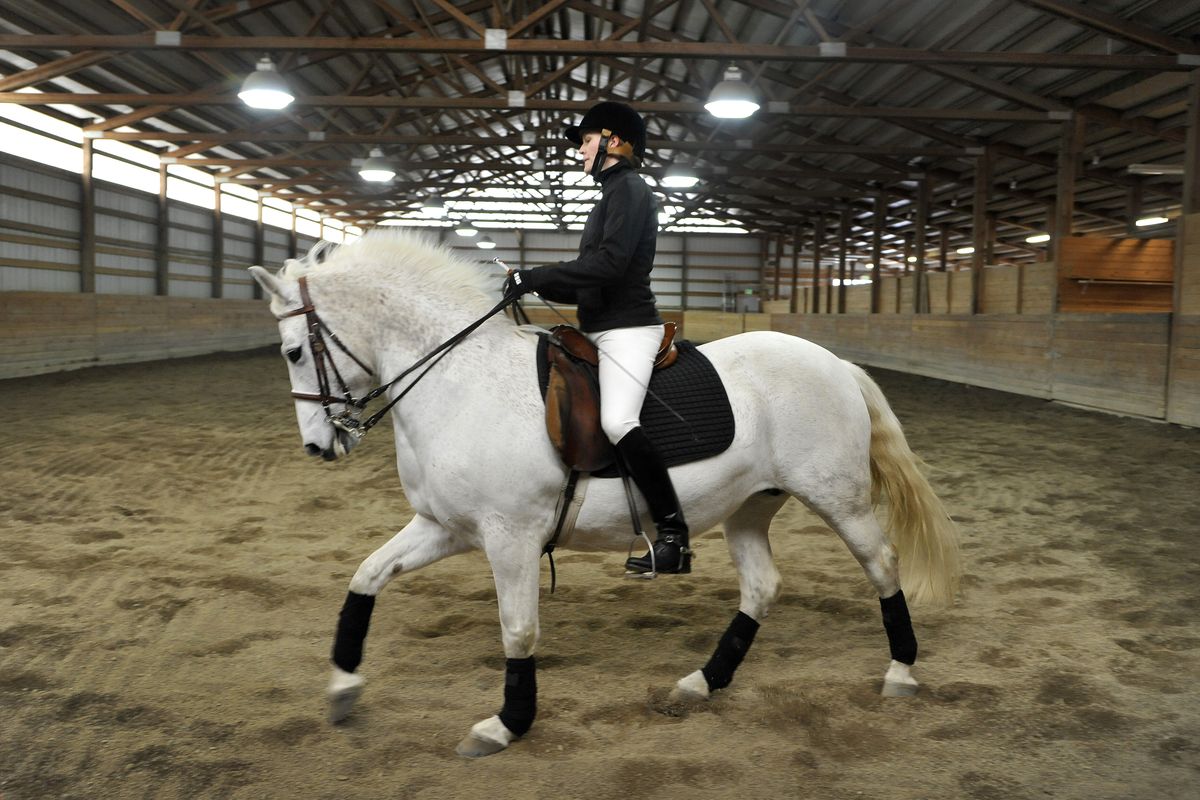Wild-hearted winner: Mustang seems unlikely dressage horse
But owner says the technical sport suits her

Mariah was a mustang in the Paisley Desert wilds of south-central Oregon before being adopted as a yearling.
The “tough little steed,” as her owner Melynnda Thiessen calls her, is now a highly trained dressage horse. The show pony skillfully performed piaffe, pirouettes and more – moves that have taken years to learn – for a small group at The Stables at Mica Meadows in Coeur d’Alene on Saturday.
“It’s hours and hours and hours and hours of training,” said Thiessen, of Spokane Dressage, who has been riding Mariah for four years. “You ride six days a week and you’re with them three hours a day. It’s a very technical sport, so it takes a lot of time.”
Dressage, a competitive equestrian sport, was developed in the last 2,000 years as a training method to achieve obedience, endurance, balance and strength in war horses – necessities for success on the battlefield. Today, dressage is seen as an art form of equestrian sport that fosters a highly intimate level of communication and harmony between horse and rider.
“The whole goal is to build communication,” said Thiessen, who communicates with 13-year-old Mariah through nearly undetectable movements and cues – a shift in weight or a small squeeze here or there.
When Thiessen first met her, Mariah was in a barn surrounded by fancier German dressage horses, prompting her to question what Mariah the mustang was doing there. But Thiessen said Mariah is just as capable as any of her swankier counterparts.
“Plus, she was cute as a bug and I just couldn’t stand it,” she said.
Most dressage horses come from carefully bred pedigrees selected for specific traits that make them good for the sport. But Mariah, rounded up and adopted out as part of the Bureau of Land Management’s wild horse management program, is of an unknown lineage, and no one had a hand in her breeding.
“That’s what makes her so unique with dressage,” she said.
Mariah is a performer at heart. In the past, she represented mustangs at natural horsemanship exhibitions and was a “poster pony” for a natural horsemanship trainer, performing tricks such as climbing onto a box and standing there on all fours, bowing or lying down. Thiessen said some of her gestures unintentionally prompt Mariah to perform her old tricks, and in the past Mariah has tried to climb on the mounting block.
“She’s so smart,” Thiessen said. “Smarter than any domestic horse I’ve ridden. She won’t forget anything, and I have to keep that in mind in our training.”
Thiessen said dressage is good for horse and rider, but injuries can happen, just like in any other sport.
“It’s great for their body, their muscles, their joints,” she said, adding the movements help deter the painful arthritis horses often come to suffer. “It’s just like an athlete.”
Together, Thiessen and Mariah earned the United States Dressage Federation Bronze Medal Rider Award in just one season, and the duo is now working toward a silver medal and on higher-level International Federation for Equestrian Sports movements. Mariah has also won Mustang of the Year at the training level.
The sport is rigorous and challenging, said Thiessen, who has been riding about 21 years, but Mariah has smarts, stamina and is willing to work hard.
“Certain horses love it,” she said. “Others don’t.”
Mariah seemed to love it Saturday as she danced around the arena to “Puttin’ on the Ritz,” the intricate footwork looking like second nature despite the complexity.
“She’s a real performer,” said Thiessen’s mom, Francie Parker.
Thiessen replied, “She sure is.”